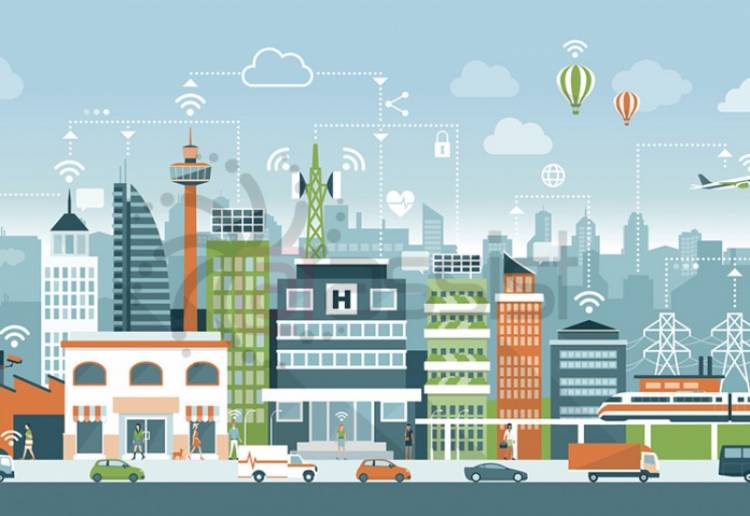Smart Cities: How Technology is Transforming our Cities
Technology is part and parcel of our everyday lives, from the smart TVs in our homes to the smartphones in our hands. And it has an increasingly important role to play in our cities, too.

Technology is part and parcel of our everyday lives, from the smart TVs in our homes to the smartphones in our hands. And it has an increasingly important role to play in our cities, too.
Our cities are evolving. They're leveraging developments in technology to become “smart cities” which can manage resources more efficiently and better meet the needs of the folks who call them home.
What are the features of a smart city?
Smart energy
• Using smart meters to measure energy usage in homes, so consumers are charged only for the energy they use and providers can better manage their operations
• Monitoring energy consumption in different areas of the city (residential, commercial and industrial) to predict and respond to changing demands for energy ahead of time
• Intelligent lighting in street lights, which change brightness automatically depending to weather and time of day (thus saving energy)
• An overall increase in energy efficiency, as more data allows the city to optimise energy production and reduce wasted energy
Smart transport
• Tracking air pollution and limiting vehicle access to certain areas of the city if needed, to maintain air quality
• Managing traffic flow by re-routing vehicles away from congested areas
• Placing vehicles for bike sharing networks and ride-hailing services where they'll be needed most
• Tracking free parking spaces and using mobile apps or communicating with in-vehicle computers so drivers are able to easily locate them
• Managing highways with sensors which send out alerts when accidents, traffic jams or poor road conditions are detected (and redirect vehicles if necessary)
• Sending out warning messages when delays are detected in bus/train/other services
• Real life example: Paris and Brussels use (or are planning to use) smart technology for driverless trains, video surveillance and improved transport operations
Improved safety
• Sensors which monitor bridge stability (for small pedestrian footbridges, multi-lane motorway bridges and everything in between) and structural integrity of buildings (like historical monuments) by tracking cracks and tilts
• Controlling traffic lights to allow emergency vehicles to reach their destinations more quickly
• Smart video surveillance cameras which only record footage when activity is detected (so relevant video evidence is easier to find if a crime takes place) and send alerts if their sensors detect the camera has been tampered with (which is common in areas prone to vandalism)
• Making sensitive areas and buildings more secure by using facial recognition or Radio-frequency identification (RFID) badges/cards to control access
Improved quality of life
• Sensors on street lamps to track air quality and noise pollution (especially in central areas with lots of bars and nightclubs), so they can be kept within acceptable levels
• Providing directions to events or destinations based on a user's mobility needs (e.g. a wheelchair-friendly route)
• Helping citizens discover stores, events and businesses which they might like and helping tourists discover the city by allowing smartphones to connect to a purpose-built platform which provides recommendations and information tailored to the user
How is all this possible? With a combination of data, communications technology, hardware, software, cloud computing, interactions and internet access...
In other words, Information and Communications Technology (ICT).
How do smart cities work?
A smart city is full of multiple objects which “talk” to each other and interact with one another, to improve your life and connect the city around you. It takes the internet of things and implements it on a massive scale.
But that doesn't just mean machines talking to each other. It also means humans and machines communicating with one another (e.g. you ask your mobile phone where the nearest parking space is, and it gives you directions there).
This creates a web of interactions, communication and data which result in tangible benefits for the citizens of the city.
A simplified overview -
• Data comes into the system from the devices connected to it. These might be sensors which monitor air pollution, electricity consumption, motorway traffic and more or smart devices like our mobile phones.
• The system processes and analyzes this data and then responds by sending out instructions to the devices connected to it, to trigger actions which generate results in real-time.
But it's a little more complicated than that -
• The system isn't just reactive. By storing the data it collects, and using a mixture of machine learning and automation, the system can proactively respond to predicted demands and changes.
• And connecting/coordinating so many different moving pieces means the system often has to optimize and prioritize competing demands for the same resources
This system requires a special kind of ICT infrastructure -
• It has to reliably (and highly secure) to handle so much data collection and storage, information processing and data transmission
• And it has to manage multiple sets of services and applications which each come with their own specific requirements
ICT is the glue which holds a smart city together - and every smart city requires a robust, flexible and responsive ICT system to ensure it can deliver benefits for its citizens.
Which one of these smart city applications would you most like to see in your own city? Let us know in the comments below.

 contact@atassist.com
contact@atassist.com 





